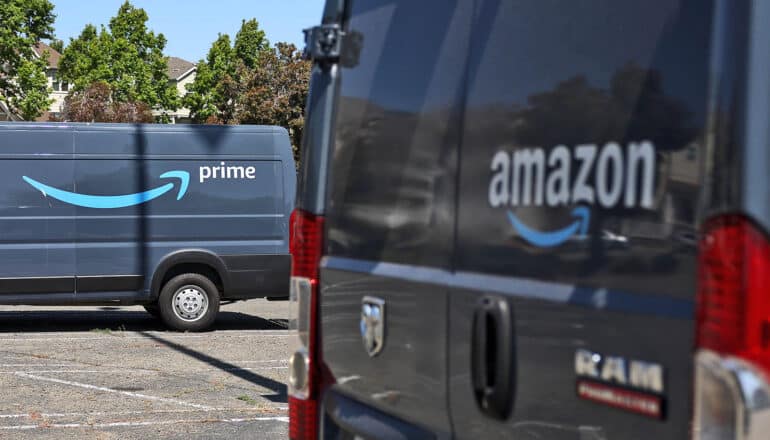
Neighborhoods within 3 kilometers (1.9 miles) of an Amazon last-mile delivery station or sortation center get twice the delivery van and truck traffic than neighborhoods farther away, a study in the Seattle metro area finds.
These neighborhoods are home to a higher proportion of low-income households and people of color compared to the rest of the metro area. These residents also order 14% fewer packages than average in this area.
Researchers were curious how the delivery of e-commerce products affects pollution levels across the Seattle metropolitan area, which includes Tacoma, Seattle, Bellevue, and Everett. They report these findings in Research in Transportation Economics.
“E-commerce is changing how we shop and how we travel in cities, but transportation researchers don’t really have a good way to measure or even talk about e-commerce in terms of equity,” says lead author Travis Fried, a doctoral student in the civil and environmental engineering department at the University of Washington. “So, we started by asking, ‘Well, who’s ordering the packages?’ which I think we have a clearer idea of now. Then we asked, ‘Who’s affected by the pollution and the traffic that this ordering creates?’ Our study found that there’s a substantial disparity between those two populations.”
Because this is the first study of its kind, the researchers started by looking for broad trends based on household income and race. “People of color” in this study included people who identified as any other race or ethnicity besides non-Hispanic white on the census. The team defined a “vulnerable” neighborhood as one with a below-average household income and a higher percentage of people of color compared to the broader metropolitan area.
To get an idea of who was ordering packages, the researchers used data from the Puget Sound Regional Council, which, in a recent survey, included a question about how many packages people were ordering on an average day.
From there, the team looked at where the neighborhoods were situated compared to Amazon last-mile delivery stations.
“Last-mile delivery stations are a unique feature to the Amazon supply chain,” Fried says. “They have trucks going in, usually from a sortation or a fulfillment center that’s a little bit further out from the city. Then coming out the other end are cargo vans—these are the cargo vans that we see circulating our neighborhoods. Ultimately, we tried to estimate this inflow of trucks and outflow of cargo vans.”
The researchers chose to focus on Amazon because it is the biggest player in the e-commerce market. Any trend they found for Amazon would likely be similar for other e-commerce companies, the researchers say.
Based on a neighborhood’s proximity to a last-mile delivery station and the residential ordering behaviors, the researchers could model how cargo vans and trucks were distributed throughout the network. Then they used the Environmental Protection Agency’s MOVES tool to simulate the amount of pollution each neighborhood would experience.
“It’s almost like each warehouse represents a sun with rays emanating out of it,” Fried says. “Those rays will be more intense the closer you are, and then as it branches out to other neighborhoods, it becomes less dense. The closer you are to something that’s hot, the more heat you will end up feeling. And these warehouses are just massive generators of freight activity. But not all that is destined for those neighborhoods nearby. And that’s where the inequity lies.”
In some ways these results are not surprising, the researchers say.
“Warehousing and distribution centers have historically concentrated in historically marginalized communities, including those with a high number of low-income households and a high proportion of people of color,” Fried says. “The concentration of industrial zoning happened through mechanisms that were either explicitly racialized during the early-to-mid 20th century or had the indirect effect of creating segregation near industrial land. Even though these policies are illegal today, we still see evidence of them locked into our modern-day development.”
The researchers hope to expand this finding in future studies by looking at how these results specifically affect different racial and ethnic groups as well as other vulnerable groups, such as older adults and people with disabilities. The team is also planning to make the model more easily accessible for other cities to use.
As for what the average consumer can do now, the answer is not straightforward.
“You could say, ‘OK, just stop shopping online.’ But then people may just be driving more to shop and there will be more cars on the road, which still leads to more air pollution,” Fried says. “There’s no easy solution to this issue. But if we’re trying to improve something, we need to at least know where we start.”
Source: University of Washington
The post Amazon’s neighbors may face more pollution but order less stuff appeared first on Futurity.
from Futurity https://ift.tt/pTwmuI0
No comments:
Post a Comment